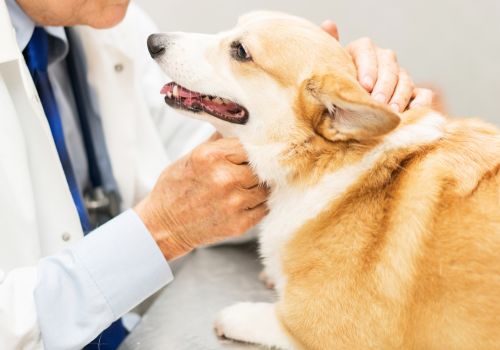As veterinarians, we understand the deep bond between humans and their furry family members. We know that you cherish your pet and that their health and well-being are paramount. When facing the challenges of Intervertebral Disc Disease (IVDD), it’s crucial for you, as a devoted pet parent, to work closely with your veterinarian to provide the best possible care and support. In this article, we will delve into the world of IVDD, discuss its symptoms, and arm you with valuable tips on advocating for your beloved pet throughout their treatment journey.
Understanding IVDD
Understanding IVDD is the first step towards becoming an advocate for your furry friend. By teaming up with your veterinarian, you can ensure that your pet's voice is heard and their needs are met, allowing them to thrive despite their challenges. Where knowledge meets compassion, you become a champion for your pet's well-being.
Intervertebral Disc Disease (IVDD) is a condition that affects the spinal discs in dogs and occasionally in cats. The intervertebral discs serve as cushions between the vertebrae (back bones), providing flexibility and shock absorption. However, in IVDD, these discs degenerate or become herniated, causing pressure on the spinal cord and nerves and resulting in pain and various neurological symptoms.
Certain breeds of dogs are more at risk for this disease due to their anatomy. A long spine and short legs predisposes Dachshunds, Corgis, and French Bulldogs to this disease but it can occur in any breed of dog.

Symptoms of IVDD
Identifying the symptoms of IVDD is crucial for early diagnosis and prompt treatment.
Keep an eye out for the following signs of IVDD:
- Pain: Your pet may exhibit signs of discomfort, reluctance to move, or cry out when touched or picked up.
- Abnormal gait: IVDD can cause a wobbly or uncoordinated walk, stumbling, or limb weakness.
- Loss of coordination: Pets with IVDD may have difficulty jumping or climbing stairs. They may also lack balance.
- Paralysis: In severe cases, IVDD can lead to partial or complete limb paralysis or loss of control over bladder and bowel movements.
Working with Your Veterinarian
If you think your pet may be experiencing IVDD symptoms, take action immediately. Your first step is scheduling an examination with your trusted veterinarian, emphasizing the urgency of the situation and providing a detailed account of your pet's symptoms. This proactive approach allows your veterinarian to prioritize your pet's needs and make appropriate arrangements for their evaluation.
Share your pet's complete medical history with your veterinarian during your visit. Be sure to provide information about any previous injuries or medical conditions your pet has experienced. Additionally, providing a timeline of your pet's current symptoms is immensely helpful in painting a comprehensive picture of their condition.
Because IVDD is a complex condition, you’ll likely have questions and concerns. Don't hesitate to speak up. Clear and open communication is key to ensuring that you are fully informed about your pet's diagnosis, the available treatment options, the potential risks involved, and the expected outcomes. By actively participating in these discussions, you become an empowered advocate for your pet's care and can make informed decisions regarding their care.
Treatment Options
Following an exam and any other necessary diagnostic testing, such as X-rays or an MRI, your veterinarian will outline various treatment options based on the severity of your pet's condition and other factors. These may include conservative management with rest, medication, physical therapy, or surgical intervention. Discuss the pros and cons of every option, as well as the associated costs, recovery time, and long-term prognosis. Together, you and your veterinarian can decide on the most suitable approach for your beloved companion. Often, a referral to a veterinary neurologist is recommended for advanced imaging and potential surgery. With proper care, your pet can make a full recovery.
Once a treatment plan is in place, adhere to it diligently. Administer medications as directed and follow any recommended exercise restrictions. Attend regular follow-up visits with your veterinarian to monitor your pet's progress and adjust the treatment plan as needed.

Other Ways to Advocate for Your Pet with IVDD
Don't hesitate to seek a second opinion if you have concerns or doubts about your pet’s diagnosis or the recommended treatment plan. Consulting with another experienced veterinarian can provide additional insights and options, ensuring you make the best decisions.
You know your pet better than anyone else. If you know they are in pain, don’t stop until you have answers.
In addition to medical treatments, several supportive care options can improve your pet's quality of life while managing IVDD. These may include physical therapy, acupuncture, hydrotherapy, or assistive devices such as wheelchairs or slings. Discuss these options with your vet to determine if they suit your pet and can fit into their treatment plan.
Helping Your Pet Between Appointments
Veterinary appointments and exams are crucial, but your pet’s IVDD requires at-home care, too. The steps you take at home can be just as vital as what happens at the vet’s office.
In addition to closely following your veterinarian’s instructions, keep a journal to record your pet's symptoms and progress. Providing accurate and detailed information is invaluable during veterinary visits and discussions.
Pay close attention to your pet's behavior, appetite, and overall well-being. Keep an eye on their weight, as well. Weight loss or gain often indicates health problems, and weight gain can increase pain in pets with IVDD. Notify your veterinarian promptly if you notice any concerning changes or worsening of symptoms.
Stay informed. Educate yourself about IVDD and its management. Read information from trustworthy sources or seek reliable online resources recommended by your veterinarian. Being informed empowers you to make informed decisions and actively participate in your pet's care.
Closing Thoughts
Advocating for your pet with IVDD involves effective communication, collaboration, and a commitment to their well-being. Working closely with your veterinarian ensures your pet receives the best possible care and support. Remember, you are an essential member of your pet’s healthcare team, and your dedication and advocacy will greatly contribute to their recovery and quality of life.
GeniusVets.com: GeniusVets

